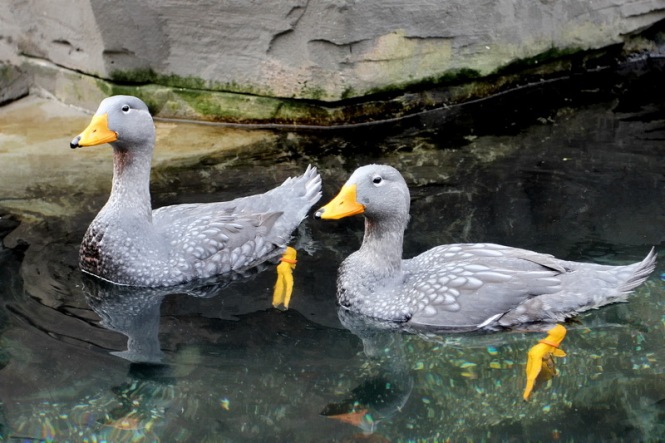Answering that question might be more difficult than expected.
Several bird species have become flightless. The ability to fly is mostly seen as a binary character: a species is either flying or flightless. However, reality is often not that straightforward. Take, for example, the steamer ducks of the genus Tachyeres. These four South American species originated within the last two million years and show different degrees of flight ability. Most individuals of the Flying steamer duck (T. patachonicus) can still fly, only the heaviest males cannot take to the skies any longer. The other three species – Fuegian steamer duck (T. pteneres), Chubut steamer duck (T. leucocephalus) and Falkland steamer duck (T. brachypterus) – are largely flightless. This situation raises the question: how many times did these steamer ducks lose the ability to fly?

Two Fuegian steamer ducks © Николай Усик | Wikimedia Commons
Candidate Genes
To answer this question, Leonardo Campagna and his colleagues sequenced the genomes of these species and pinpointed the genomic regions underlying the loss of flight. A genome-wide association analyses (GWAS) uncovered two regions on chromosome 1 which contain 28 genes with known functions. Flightlessness is probably influenced by several genes, although one candidate gene seems especially promising: DYRK1A. In humans, this gene is involved in Down Syndrome and experiments in mice revealed that high levels of DYRK1A lead to skeletal abnormalities. The authors hypothesize that differential expression of DYRK1A could explain the morphological differences in steamer-ducks.

Results from the GWAS analyses shows two large peaks on chromosome 1. These regions contain several genes of which DYRK1A (in blue circle) is a promising candidate for further research. From: Campagna et al. (2019) Evolution.
Flighted Alleles
Phylogenetic analyses of the genome-wide data set revealed that the three species of flightless steamer ducks are not monophyletic. This result, which is consistent with previous work using mitochondrial DNA, suggests that the ability to fly was lost independently three times. There is, however, a second possibility. Two flightless species – pteneres and leucocephalus – have similar genotypes in the candidate regions. Perhaps the genetic variants for flightlessness were already present in the ancestor of these species. This would point to a single genetic origin of “flightless alleles” which consequently segregated in the different species. In some species, these alleles go to fixation, leading to flightless birds. In other species, these alleles do not completely replace the “flighted alleles”, resulting in a few individuals that can still fly.
This latter situation might explain the occurrence of some flying brachypterus ducks. Interestingly, flying individuals of this species possess the same genotypes as the flying patachonicus ducks. Possibly, brachypterus obtained these “flighted alleles” through introgressive hybridization with patachonicus ducks. This scenario is supported by the observation that several patachonicus birds possess mitochondrial DNA from brachypterus. Hybridization is relatively common in birds, often resulting in the exchange of genetic material. The possible acquisition of “flighted alleles” through hybridization has an interesting implication. It provides a plausible mechanism for regaining flight, an evolutionary transition that has been deemed unlikely.

Two scenarios for the loss of flight in steamer ducks. Blue color indicated flighlessness, while red points to flighted birds. Color gradients represent polymorphism of “flighted alleles”. (A) three independent losses (indicated by the three black arrows) or (B) a single genetic loss (black arrow), followed by transfer of “flighted alleles” from T. patachonicus to T. brachypterus (grey arrow). From: Lele & Ottenburghs (2019) Evolution.
Another digest
I also wrote a digest about this study (you can read it here). Digests are short news articles about selected original research included in the journal Evolution written by students or postdocs. The story behind this digest is quite interesting, so I decided to cover it in more detail on my personal website. You can check it out here.
References
Lele, A. & Ottenburghs, J. (2019) Digest: A single genetic origin and a role for bone development pathways in repeated losses of flight in steamer ducks. Evolution.
Campagna, L., McCracken, K. G., & Lovette, I. J. (2019). Gradual evolution towards flightlessness in Steamer‐Ducks. Evolution.
The papers have been added to the Anseriformes page.
[…] whereas I was mainly interested in hybridization (you can read more about the study on my blog Avian Hybrids). The two digests nicely complemented each […]
[…] form between a flying ancestor and the flightless C. lawi (similar to Tachyeres ducks, see this blog post). Based on several morphological traits, these extinct species were considered sea ducks (tribe […]